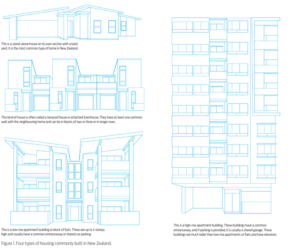Got a new multi-dwelling project kicking off?
Mar 20, 2024

Over the last 18 months, consents for multi-unit dwellings have grown to the point where there are more multi-unit consents each month than for standalone houses. Coupled with the current economic climate and the security that comes from Council, Kainga Ora or Government work means we are seeing more and more of our residential builders starting to work beyond the more traditional single dwelling build.
How do you define Multi-Dwelling Housing?
There are three different types of residential housing – low density, medium density, and high density.
- Low density – Usually 1-2 story residential building on an individual section
- Medium density – Multi-unit residential building on a single site eg townhouses, units, apartments and retirement villages
-
- 1–2 story attached houses (e.g. duplexes, triplexes, semi-attached terraced houses)
- 2–4 story attached houses (terraced houses)
- 3–6 story apartments
- High density – Apartment buildings, greater than 6 stories
With increasing pressure on New Zealand’s building stock, medium density housing is considered an attractive option to meet the changing housing needs. Demand for more compact homes is increasing, particularly in areas with rapid population growth (BRANZ, 2023). Multi- dwelling consents made up 48% of all consents in 2021 and were forecasted to continue to increase (Stats NZ, 2021).
What’s the difference?
The key difference between low and multi dwelling housing is the level of complexity required to manage the build and the likelihood of additional layers of responsibility e.g. directors and development owners as PCBU’s above the building contractor.
This complexity of communication around safety means that the builds are often not solely run by a Group Home Builder or single builder and their subbies. Instead, for example, they can be run by project management companies, involving large stages of the build process that is then run and managed by specialists. This adds additional complexities compared to low density housing.
There are often complex stages of these builds, which are generally run by specialised subbies e.g. planning (engineers, architects, quantity surveyors), and build stages (civil works, construction management, carpentry/joiners, concreting) etc.
Multi-dwelling Residential Requirements
Because multi-dwelling housing creates more risk on-site due to the increased amount of subbies, machinery, equipment, and high-risk work taking place, It’s important that you have the right H&S tools in place for your contractors and a safe system of work e.g Site Specific Safety Plan (SSSP) for all medium density builds.
A SSSP for a multi-dwelling build will outline how all involved parties will manage health and safety on-site. This includes a detailed agreement between parties on how they will manage subbies, their expectations, roles, and responsibilities to ensure that all relevant site safety information is available.
The SSSP is intended to be a detailed agreement and communication tool. Due to the potential complexity of multi-dwelling builds, we always recommend a more detailed and customised SSSP.
The extra complexities that can need extra planning and control include:
- Pre-planning of the project, because there are many moving parts, schedules and sensitive timelines.
- Detailing key parties, subbies, and their contact details.
- Multiple responsibilities, e.g. engineers, main contractors of key stages, multiple teams of trades.
- Outlining those shared responsibilities, and the expectations around how safety is to be managed e.g. who is in charge or what, how is information to be gathered and passed on and to whom. Who is in control of managing risks and when?
- The SSSP allows for the detailing of the hazards and risks that are likely to be faced, and what controls are to be used to reduce or eliminate those.
- Plans for emergencies and the site’s response throughout the build.
- Any specific requirements e.g. if working for a government entity, or any specific standards.
- More complex site boundaries e.g. large areas, houses that are sold whilst construction continues in other parts, site boundaries in close proximity to pedestrians etc.
- Traffic management needs, e.g. more trade parking, higher traffic flow of machinery or materials, cranes and concrete pump trucks, council requirements etc.
This list is not exhaustive but all of these complexities are often above and beyond a low density build and need planning, controlling, and communicating to ensure the health and safety of workers and others are managed well.
Got a new multi-dwelling build kicking off?
Project Pro and the HazardCo system are suitable and capable of meeting the H&S requirements of multi-dwelling builds, so you can feel confident that HazardCo can support you as your business grows.
If you are a builder starting to diversify, now’s the right time to review your Health and Safety activity.
That’s where HazardCo comes in. If you’re building 3 or more dwellings within a fenced-off section, you will need HazardCo’s Project Pro. This is a customised project, specifically for your build that gives you everything you need for your team and all the subcontractors you will have coming onto the site.
Here are some key components of Project Pro that will help you cover all your bases.
- 2 x Hazard Board with QR code
- Customised SSSP for the project (reviewed by a H&S Advisor)
- Large HazardCo mesh fence banner
- Full access to the HazardCo system to guide anyone scanning onto site
- In app guided activity to support learning
- Cloud storage of all safety documentation completed on site
- Reporting and analytics to identify opportunities and trends on site
- Support from our Customer support and Advisory teams
If you have a new multi-dwelling residential project kicking off, give us a call on 0800 555 339 or email info@hazardco.com to discuss your requirements and what you need to be thinking about from a H&S perspective and the added complexities that come with it.













